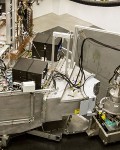The ultimate goal to truly integrate modeling into the experimental chain is the ability of a researcher to interact even with complex simulations 'live' before and during an experiment. In a recent experiment on SrTiO3 on the HYSPEC instrument at the SNS, we ran ab-initio molecular dynamics (AIMD) simulations on the OLCF EOS cluster concurrently with the experiment. The CAMM developed SimPhonies software was used to compute the neutron scattering intensity that was simultaneously being measured on the HYSPEC instrument. The AIMD simulations used 23,000 computing cores on EOS (a Cray XC30 cluster), and were executed at the same time as the neutrons scattered by the sample were accumulated by the HYSPEC detector system, thanks to the OLCF mechanism for scheduling jobs synchronized with the SNS experiment. The calculations ran for 5 hours, in order to compute 100,000 configurations of ions in the simulation box, using density-functional theory, from which anharmonic interatomic force-constants were extracted to compute the 4D phonon dynamical structure factor S(Q,E). Concurrently, the experimental 4D S(Q,E) was mapped on HYSPEC by rotating a large, high-quality single-crystal (grown at ORNL) over a large range of orientations.
Because the paraelectric cubic phase of SrTiO3 is stabilized by anharmonicity (it distorts into a lower symmetry antiferroelectric phase at low temperatures), it is crucial to perform these large AIMD calculations in order to capture the anharmonic renormalization (stabilization) of phonon dispersions, and achieve good agreement with the experiments (in the sample, thermal agitation at room temperature naturally performs the renormalization). Simpler harmonic calculations would otherwise predict unphysical results. By slightly adjusting the volume in the AIMD simulations, based on the observed scattering intensity, we were able to achieve pretty good agreement between theory and experiment, as illustrated in the plots below. The simulations also helped us refine the range of crystal orientations that were collected on HYSPEC. The results are currently being analyzed in more detail.


![Figure caption: Comparison of plan of S(Q,E) along [HH1] direction. The graph on the left shows the experimental data from HYSSPEC and the graph on the right shows calculated intensities. Figure caption: Comparison of plan of S(Q,E) along [HH1] direction. The graph on the left shows the experimental data from HYSSPEC and the graph on the right shows calculated intensities.](https://sns.gov/sites/default/files/styles/homepage_800x450/public/field/image/figure.png?itok=hizb05Q6)


